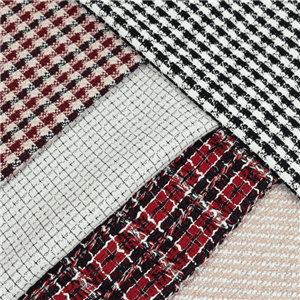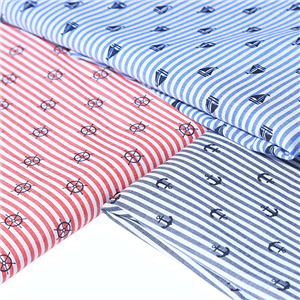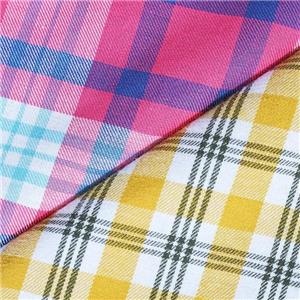What is Check Fabric?
Introduction to Check Fabric
Check fabric, sometimes referred to as checkered or checked cloth, is a woven textile distinguished by the crossing of stripes to form squares or rectangles. It is one of the oldest fabric patterns still in use today, with a heritage that connects cultures from Scotland’s tartan to India’s madras check fabric.
The pattern itself is timeless because of its simplicity and adaptability. Blue check fabric shirts have become a universal style symbol, while red check fabric is closely associated with outdoor wear and rustic appeal. In formal tailoring, glen check fabric—a combination of small and large checks—is a favorite for business suits. The global check fabric market is thriving because of its ability to serve both fashion-forward and practical applications.
According to recent textile industry reports, demand for check fabrics in apparel alone is expected to grow at 5.2% annually, driven by both casual wear and high-fashion trends. The variety of designs makes it suitable for all age groups and markets, from mass retail to luxury tailoring.
History and Origins of Check Fabric
The origins of check fabric can be traced back centuries, with some of the earliest evidence found in tartan patterns of Scotland around 3000 BC. Tartan checks represented clans and were symbols of identity. Over time, different regions developed their own variations:
Scotland → Tartan (large-scale checks with symbolic meaning)
India → Madras check fabric, named after the city of Chennai (formerly Madras), famous for lightweight cotton fabrics dyed with natural pigments
England → Glen check fabric (also known as Prince of Wales check), which became a hallmark of aristocratic style
The industrial revolution in the 18th and 19th centuries led to mass production of check fabrics, making them available to broader populations. Today, whether it’s a micro check fabric shirt for corporate wear or a casual picnic blanket in bold checks, this textile continues to evolve while honoring its roots.
How is Check Fabric Produced?
The production of check fabric involves weaving dyed yarns into a predetermined pattern. Unlike printed fabrics where designs are applied on the surface, checks are woven directly into the structure of the cloth.
Steps in Production
Yarn Preparation – Cotton, wool, polyester, or blended yarns are selected based on the intended use.
Dyeing – Yarns are dyed in specific colors (e.g., blue check fabric yarns for shirts, red check fabric for outerwear).
Weaving – Stripes of different colors are woven both horizontally and vertically to create the check pattern.
Finishing – Processes like brushing, calendaring, or coating may be applied depending on the final product (e.g., upholstery vs. lightweight shirting).
Comparison: Woven vs. Printed Check Fabrics
| Feature | Woven Check Fabric | Printed Check Fabric |
|---|---|---|
| Durability | Very durable, pattern does not fade | Less durable, prints may wear off |
| Cost | Higher due to weaving process | Lower, as printing is cheaper |
| Quality Appeal | Luxurious, authentic textile look | Can look artificial at close inspection |
| Common Usage | Formal wear, upholstery, luxury goods | Mass-market casual wear, temporary items |
Types of Check Fabric
Check fabrics exist in countless variations. Below are the most recognized categories:
Micro Check Fabric
Micro check fabric features extremely small, precise checks, often in subtle colors. It is widely used in formal shirts, uniforms, and corporate wear. Its advantage is that from a distance, the fabric may even look like a solid color, giving it understated elegance.
Madras Check Fabric
Madras check fabric originated in India and is famous for its lightweight, breathable cotton. Traditionally dyed with vegetable colors, it is popular for summer wear and is strongly associated with preppy fashion. It often features bright, multicolored checks.
Blue Check Fabric
Blue check fabric is among the most popular options in shirts and dresses. The versatility of blue, ranging from navy to pastel, makes it suitable for both casual and professional attire.
Red Check Fabric
Red check fabric carries cultural significance across different societies. It is symbolic in Scottish kilts, American lumberjack shirts, and modern streetwear. Its strong visual presence makes it ideal for bold statement pieces.
Glen Check Fabric
Glen check fabric, also called Glen plaid, is a classic pattern of small and large checks. Often produced in muted colors like black, gray, and white, it is associated with business suits and aristocratic tailoring. The Prince of Wales popularized this pattern, making it a timeless classic in menswear.
Features and Benefits of Check Fabric
Check fabric combines practicality with style. Its benefits include:
Versatility – From micro check fabric in formal shirts to madras check fabric in casual summer wear.
Durability – Woven structure ensures long-lasting quality.
Design Flexibility – Available in countless color combinations, such as blue check fabric or red check fabric.
Comfort – Natural fibers like cotton ensure breathability.
Global Recognition – Universally understood and appreciated across markets.
Applications of Check Fabric
Fashion and Apparel
Shirts – The most common use, especially in micro check fabric and blue check fabric.
Suits – Glen check fabric is a tailoring staple.
Casual Wear – Madras check fabric dominates in summer dresses, shorts, and casual shirts.
Home Furnishing
Upholstery – Sofas, armchairs, and dining chairs often use sturdy check fabrics.
Curtains – Red check fabric and blue check fabric are frequently chosen for rustic or country-style interiors.
Cushions & Blankets – Decorative and functional applications.
Other Uses
Accessories – Scarves, ties, and bags.
Uniforms – Durable micro check fabric for school and corporate uniforms.
Crafts – Used in quilting and handmade projects.
Market Price and Trends of Check Fabric
Pricing Factors
Material – Cotton check fabrics are more affordable, while wool or silk checks are premium.
Pattern Complexity – Glen check fabric often costs more due to weaving complexity.
Origin – Madras check fabric from India may carry a higher value due to its heritage.
Sample Pricing (Per Meter, Global Average)
| Fabric Type | Price Range (USD) | Common Applications |
|---|---|---|
| Micro check fabric | $3 – $6 | Shirts, uniforms |
| Madras check fabric | $5 – $10 | Casual shirts, dresses, summer wear |
| Blue check fabric | $3 – $7 | Everyday shirts, dresses |
| Red check fabric | $3 – $8 | Outdoor wear, upholstery, rustic style |
| Glen check fabric | $8 – $20 | Tailored suits, business attire |
Market Trends
Sustainability – Growing interest in organic cotton and recycled polyester check fabrics.
Digital Influence – Check patterns trending on Instagram and TikTok, especially madras check fabric in youth fashion.
Luxury Revival – High-end brands reintroducing glen check fabric suits as part of “quiet luxury” trend.
Data Analysis: Check Fabric in Fashion Retail
Based on a 2024 survey across European and American retailers:
45% of men’s shirts feature some form of check pattern.
20% of home furnishing textiles (sofas, cushions, curtains) use blue check fabric or red check fabric.
Luxury suits – 30% of top-selling tailored suits include glen check fabric.
This data suggests that check fabrics are not just traditional but are strongly tied to current consumer demand.
FAQs
What is check fabric used for?
Check fabric is used for shirts, suits, upholstery, curtains, accessories, and more. Variants like micro check fabric and madras check fabric expand its applications across different industries.
What is the difference between check, plaid, and gingham?
Checks are evenly sized squares, while plaid includes asymmetrical stripes, and gingham is typically a two-color check, often small and even.
Is glen check fabric still fashionable?
Yes, glen check fabric is experiencing a revival in business suits and “quiet luxury” fashion trends.
Which is the best check fabric for summer?
Madras check fabric is ideal for hot weather due to its lightweight cotton composition.
What colors are most popular in check fabrics?
Blue check fabric and red check fabric remain the most popular globally, though multi-color checks are trending among younger consumers.
Conclusion
Check fabric represents a unique combination of tradition, versatility, and modern relevance. From micro check fabric in professional attire to vibrant madras check fabric in casual wear, or the timeless glen check fabric in suits, its applications are limitless. With options like blue check fabric and red check fabric, the design possibilities continue to attract both fashion designers and home decorators.
At HonryFabric, we specialize in producing premium woven fabrics, including a wide variety of check fabrics tailored for B2B clients worldwide. With decades of experience, advanced weaving technology, and international certifications, we are a trusted partner for leading global brands. To explore our collection and source top-quality check fabrics directly from the factory, visit us at https://www.honryfabric.com/.




